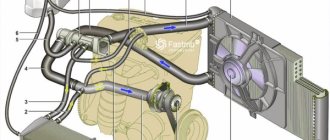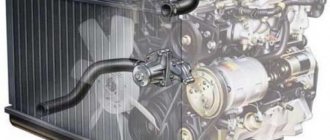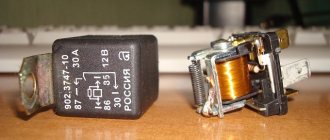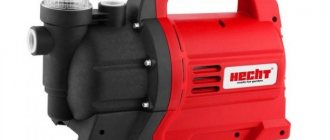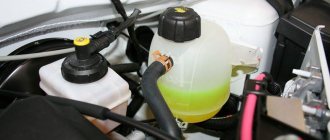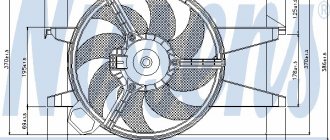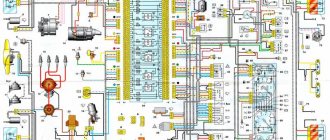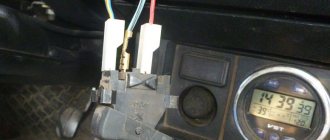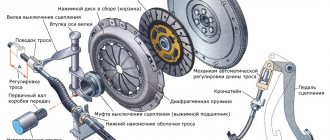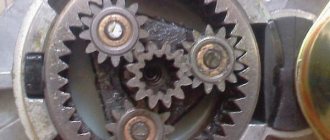3.8/5 — (81 votes)
VAZ 2106 engine cooling system diagram Today we will look at all the elements that make up the VAZ 2106 cooling system, and most importantly, we will learn how to replace the coolant, thermostat, and water pump. In the very first photo you can see all the elements of the system; it is on this basis that the entire story will now be built. It will also be discussed how to replace the coolant in the system, as well as how to get rid of air locks.
Engine overheating: main signs and causes
Let's start with the signs. First of all, this is the engine temperature indicator on the dashboard in the red zone. Also, on some models, a warning light may simply light up, indicating overheating.
Another sign of engine overheating is a decrease in engine power, loss of traction and detonation knocks when you sharply press the gas pedal or simply when accelerating. The reason is that the combustion process in the cylinders is disrupted due to an increase in temperature (explosions of the working mixture instead of combustion).
Let's move on
It is important to understand that the normal operating temperature of the engine is 85-95 degrees Celsius. Also acceptable is an engine temperature of up to 100 degrees or even 105, especially if such an increase is short-term (up to 5 minutes). Drivers often encounter this situation when sitting in a traffic jam in the heat.
Drivers often encounter this situation when sitting in a traffic jam in the heat.
However, if the engine temperature is above 105 degrees, then this is already overheating and you need to look for the reasons. The simplest and most understandable is the low level of coolant in the cooling system. Let us also add that the liquid in the engine boils at a low level, since the contact surface of the liquid and the heated motor is insufficient, that is, heat removal is impaired.
You also need to take into account that the cooling system is not completely sealed and closed. During operation, the liquid evaporates, which causes the level to decrease.
Often the radiator, pipes and connections begin to leak. Internal leaks should not be ruled out yet, when coolant enters the cylinders through cracks in the cylinder head or cylinder head, as well as through a broken gasket.
It is also important to check the condition of the radiator. The radiator honeycombs are small, often the radiator becomes dirty from the outside. The circulation of coolant inside the radiator may also be impaired due to the accumulation of deposits
In this case, when the engine cooling fan turns on, a cold engine radiator may indicate problems with fluid circulation
The circulation of coolant inside the radiator may also be impaired due to the accumulation of deposits. In this case, when the engine cooling fan turns on, a cold engine radiator may indicate problems with fluid circulation.
By the way, deposits on the engine walls and inside the radiator often occur after using low-quality coolant or, even worse, water. In the first case, cheap antifreeze or antifreeze does not protect parts from corrosion, does not have cleaning properties, etc. In the second, the water itself contains impurities and salts. It is recommended to thoroughly rinse the car radiator from rust, as well as clean the entire system.
- In many cases, the electric radiator fan is triggered by a sensor signal. If the sensor does not give a signal, the fan will not work or may not work properly.
- Air pockets may well form in the cooling system. It is noteworthy that the temperature sensor may not indicate overheating. In any case, the air plug must be “expelled”, which will eliminate the presence of air.
- Another reason why the engine is running hot, the radiator is cold and the cooling fan is constantly running is the thermostat. In a nutshell, the thermostat is a valve that divides the cooling system into two circles through which coolant circulates. The small circle involves circulation only through the cooling jacket for quick warm-up, while the large circle allows fluid to pass through the radiator for improved cooling.
However, if the thermostat sticks, then the coolant can only circulate in a small circle, that is, the radiator is cold, but the engine overheats. For an accurate determination, it is enough to feel the lower pipes going to the radiator. Cold pipes with an overheating engine are a sign of problems with the thermostat.
The list of major breakdowns is completed by the pump (water pump of the cooling system). This pump forces coolant through the system to achieve better circulation.
As a rule, the pump either begins to leak or its impeller wears out. Less often the pump jams. In the case of a cold radiator, provided there is no pump leakage, it is appropriate to talk about wear on the impeller. In simple words, the pump pumps liquid poorly, the coolant in the engine (small circle) heats up much faster than in the radiator itself. It turns out that the heating is uneven, the radiator is cold, and the engine is boiling. Let us remind you once again that similar symptoms also occur in the case of air locks.
https://youtu.be/https://youtu.be/tVZI0WCXRXk
_
Coolant replacement
Antifreeze circulating through the cooling circuit of the VAZ 2106 gradually loses its anti-corrosion properties, becomes dirty and forms scale. Therefore, periodic replacement of the fluid is necessary at intervals of 2-3 years, depending on the intensity of use. Which coolant is better to choose:
- initially the manufacturer recommended pouring G11 class antifreeze, colored blue or green (this also includes antifreeze, invented in the USSR);
- it is allowed to fill with liquid of classes G12 and G12+, made on the basis of ethylene glycol, the color is predominantly yellow and orange;
- the best and most modern option is G13 antifreeze based on propylene glycol, color – pink or purple.
To replace antifreeze in the cooling circuit of a VAZ 2106, you need to purchase 10 liters of new fluid and follow the instructions:
- While the engine is cooling, remove the dust shield located under the radiator drain plug. It is fastened with 4 8mm key screws.
- Open the stove tap, place a container under the drain neck of the body exchanger and remove the plug. A small amount of liquid will drain.
Brass radiators may not have a drain outlet. Then you need to unscrew the temperature sensor or remove the large lower hose and drain the antifreeze through the pipe.
To prevent air pockets from forming when filling the circuit with new fluid, you need to remove the hose at the highest point of the system. On carburetor versions this is the manifold heating tube, on injection versions it is the throttle valve.
Fill through the upper neck of the radiator, observing the removed pipe. As soon as antifreeze flows from the hose, immediately put it on the fitting. Then install the heat exchanger plug and add fluid to the expansion tank. Start the engine, warm it up to a temperature of 90 °C and make sure that the radiator housing is warmed up from top to bottom.
Video: how to correctly change the coolant on a VAZ 2106
The VAZ 2106 cooling system does not require much attention from the car owner. The driver will be informed about emerging problems related to engine overheating by the liquid temperature indicator on the instrument panel
During operation, it is important to monitor the level of antifreeze in the expansion tank and the appearance of wet spots under the car, indicating leaks
Expansion tank
It would seem that one can talk about such a simple and uncomplicated element as an expansion tank. On the one hand, any container that satisfies certain conditions can be used as it. But without this unit the cooling system of the VAZ-2106 will not be able to work normally. The volume of liquid always changes, it is not constant. But there is no more room for it in the pipes, engine jacket and radiator. And the reason that the volume of a liquid changes is the constant fluctuation of its temperature.
When the temperature increases (heating), the distance between the molecules of the substance increases. Everyone knows this from a physics course. Now imagine if the temperature of the antifreeze increased from zero to 80 degrees. Of course, its volume will also become larger. And the excess liquid has to go somewhere. They go through the pipe into the expansion tank. When the temperature drops, the volume steadily decreases. And all the excess that went into the tank is returned to the radiator and pipes.
Device
The first place where the fluid begins its flow is the radiator. On VAZ 2106 models, two types of radiators were installed - copper and aluminum. The first one is of higher quality, and if cracks appear on its surface, they can easily be welded. In contrast, any crack on an aluminum part is its certain death.
The radiator figuratively consists of three parts: the upper barrel, the cooling honeycomb and the lower barrel. The upper tank has a filler neck for adding coolant. During operation, hot liquid that has gone through one cycle is collected in this tank. Further, it descends into the lower barrel, through the honeycombs, simultaneously being cooled by a fan. And in the lower tank, the liquid is already completely cooled and ready for use.
Radiator design
Tubes are connected to the radiator from above and below: two wide and one narrow. A narrow tube connects the radiator to an expansion barrel, designed to allow excess liquid to enter it during heating and expansion. The upper wide tube connects the part to the thermostat, which, in turn, uses a valve to regulate the flow of coolant. Fluid can flow from the thermostat either back to the engine cylinder block or to the radiator.
For forced circulation, the system includes a pump that pumps antifreeze, creating pressure inside the block. Between the cylinders, a specially made void is provided, where this liquid enters.
Purpose
Engine cooling serves to forcibly remove temperature from heated parts. During the working stroke, a temperature of 700 - 800 degrees is created in the cylinder. If it is not forcibly lowered, the rubbing parts may expand greatly, and the crankshaft will jam.
Scheme of work
In addition to the fact that the liquid circulates inside the cylinder block, it is also further cooled when it enters the radiator. Thus, engine operation can be continuous.
The engine is breathing
The breather is designed to relieve excess pressure from the crankcase, ventilate it and remove gases generated during its operation. If there is a malfunction, smoke begins to pour out of all engine openings. Oil consumption increases sharply.
There can be three reasons for this problem:
- The ventilation system is dirty. Due to the fact that a blockage has formed in the ventilation, the pressure is not released in time. Gradually, gases accumulate and when the pressure reaches a critical value, a sharp release of accumulated gases occurs. The tube that connects the breather to the manifold flies out. As a result, the driver hears a loud bang. Sometimes the gases can rupture the valve cover, break engine parts and even tear out the pan. To correct the situation, you need to flush the ventilation system using a special additive. You can also disassemble the breather yourself and clean the filter using gasoline.
- Occurrence of piston rings. Gases begin to penetrate into the crankcase, from where, due to increased pressure, they find outlets in various cracks. Oil begins to squeeze out through the dipstick or flows into the combustion chamber. The “check” lights up on the dashboard. In this case, you need to check the compression and diagnose the condition of the engine. If at least one “boiler” shows less than 11 points, it is necessary to disassemble the engine and look for damage.
- Damage to cylinder liners. If the two previous possible causes are not confirmed, look for the cause in the cylinder-piston group. If the liners are damaged, you need to grind the cylinders and install new pistons.
Thermostat and cooling system upgrades
Before we begin the modernization, we will study the article about the features of the cooling system of VAZ cars.
In short, the essence of the problem lies in the imperfect operation of the VAZ thermostat and the cooling system; to solve it, we will make minor modifications.
Cooling system upgrade
- Remove the thermostat by first draining the coolant and disconnecting the pipes.
- We swap the expansion tank pipe and the pipe coming out of the VAZ 2110 stove.
Thermostat upgrade
We disassemble the removed thermostat and find the bypass channel, the hole of which is the cause of the lack of heat.
Let us immediately note that this upgrade is only valid for a 5-hole thermostat. Learn in detail how 6 and 5 hole thermostats differ.
Reducing the thermostat bypass channel
- From a piece of thin aluminum we cut a plate exactly in the shape of the lower part of the bypass channel.
- We secure it using self-tapping screws.
- Drill a hole in the plate with a diameter of 6-7 mm
- We assemble and install the thermostat in place.
- We connect all the pipes, not forgetting to swap places between the expansion tank pipe and the pipe coming out of the VAZ heater stove.
The engine does not warm up for a long time
With the arrival of cold weather, many car owners notice that the engine takes a very long time to warm up. Sometimes you need to drive a considerable distance in order for the temperature to at least approach the operating temperature. Why does this happen?
The temperature considered normal (operating) for different engines may differ, but on average this value is 90 degrees. If you have driven, say, ten kilometers in normal mode, and the temperature gauge does not show more than 70, then you can safely say that the engine is not warming up.
A device called a “thermostat” is responsible for the thermal balance of the engine. This is a kind of valve that switches the movement of coolant between two circuits - small and large - depending on its temperature. A large circuit runs through the main radiator, located between the headlights, where the fluid cools the most. The operating thermostat allows coolant to flow into the radiator when it reaches a certain temperature, and until that point, the fluid circulates around the radiator for faster heating.
Sooner or later, the thermostat stops working and, according to the law of meanness, its valve jams in the most “inappropriate position”: in the summer - on a small circle (the engine overheats, read why the engine on a VAZ-2106 gets hot), and in winter - on a large circle (cold fluid constantly goes through the radiator). Due to premature cooling in the radiator, antifreeze or antifreeze cannot heat up to operating temperature, which affects the general operating conditions of the engine.
An engine that is unable to reach operating temperature consumes more fuel and moving parts experience premature wear. The situation also affects the comfort in the cabin - the air coming from the heater is far from hot.
What to do? Ideally, the thermostat needs to be changed. However, if you need the car every day and there is no time for repairs, you can use two methods.
The first is to insulate the radiator. This can be done with ordinary cardboard placed between it and the radiator grille. This classic technique has been used for many decades in severe frosts, but if there are problems with the thermostat, it is not a sin to use it even at low subzero temperatures. By closing the radiator, you will block the air flow to it and reduce the cooling of the liquid - the engine temperature will increase.
The second method is to reduce the temperature of the air from the heater. The interior “stove” is essentially the same radiator, only small (read how to flush the heater radiator) and cools the engine well. By lowering the temperature on the heater control panel, you will raise it at the engine.
When driving with the thermostat not working and the radiator closed, it is important to monitor the engine temperature. The thermostat valve may “wedge” due to vibration and the device will start working. Since the main radiator is closed, the engine may not only reach operating temperature, but also overheat
Since the main radiator is closed, the engine may not only reach operating temperature, but also overheat.
But if there is severe frost outside, below -25 degrees, then, even with a working thermostat, the engine may not warm up. This is a normal phenomenon and can be corrected with the same cardboard in front of the radiator. This method was used by our great-grandfathers, and it still lives today, not only on Russian cars, but also on foreign cars.
In severe frosts, it is also important to take care of insulating the hood. You can glue its lid on the inside with noise- or heat-insulating materials or use a special insulating cape. If you're going on a long road trip and the forecast is warmer, make sure the cooling fan is working properly to avoid overheating the engine.
If you're going on a long road trip and the forecast is warmer, make sure the cooling fan is running properly to avoid overheating the engine.
And, finally, a trick that can be used to temporarily revive a jammed thermostat. If the design of the car allows, you can quietly but sharply hit the thermostat housing with the handle of a screwdriver or a wrench. Often, from such a blow, the thermostat valve breaks away from its wedge position and begins to work normally. You need to understand that such a measure is temporary and, when the engine is restarted, the valve will most likely jam again. Therefore, you need to replace the thermostat with a working one as soon as possible.
Source
Malfunctions
Quite often, on VAZ 2106 cars, the engine cooling system fails and requires repair. The main elements that are most subject to wear are the radiator and thermostat. More rarely, the cause of failure is in the pipes. In order to determine that there is a malfunction in this particular system, it is enough to know its characteristic symptoms. The first thing that immediately becomes noticeable is engine overheating. At the same time, in the area of the legs of the passenger and driver, high temperature and hot air flows will be felt. The cause of this malfunction may be either a failure of the thermostat or radiator, or wear of the pipes.
The difference is that when cracks appear in the pipes, a leak of antifreeze or antifreeze will be visually noticeable. It will ooze out, either from cracks or from joints. When you open the hood, there will be visible places on the engine parts that differ significantly from the basic condition, especially in their shine. This effect is obtained due to the constant exposure of the coolant to the same part of the coating.
If the radiator or thermostat is broken, there may not be any drips, but in this case, the antifreeze simply does not enter the radiator, but constantly circulates in the system, not having time to cool, and as a result, boiling away.
The most common cause of antifreeze leakage from a VAZ 2106 engine is wear of the radiator cap valve. It is not possible to determine its failure immediately. If after each trip the antifreeze level decreases, then carry out the following procedure. Immediately after the engine warms up, open the hood and pull out the choke a centimeter so that the crankshaft speed reaches 2000 - 2500 rpm. Keep a close eye on the lid. If, over time, liquid begins to emerge from under it, then this is clearly the reason.
How to flush the outside of an engine cooling radiator?
A car radiator mostly consists of tubes in which antifreeze circulates and so-called cooling fins located between them. With the help of a fan or while the machine is moving, air passes through the fins, which cools them. These fins are placed very close together for efficiency, so it is not surprising that they often become clogged with leaves, sand, midges and dirt.
This means that the radiator should be periodically washed not only inside, but also outside. But the problem is that the radiator is a rather fragile element in the car. The metal thickness of the radiator can be as little as 0.15 mm or even less. In practice, the radiator fins can be bent even with your finger. Therefore, strong water pressure can damage the entire radiator.
Therefore, the cleaning procedure must be gentle. Do not wash the cooling radiator with a high pressure washer. It is permissible to water only under low pressure. An alternative is to use compressed air, but you also need to be careful with the pressure. For mechanical cleaning, it is best to use a brush; even a sponge may be too harsh.
Let's start flushing the radiator
In general, flushing the outside of a cooling radiator is a fairly simple operation. Let's look at the whole procedure step by step:
- The first thing you have to do is provide yourself with free access to the front of the radiator. To do this, you often have to remove the grille and radiator fan, and sometimes the bumper.
- Next we act depending on the contamination of the radiator:
- If the cooling element is relatively clean, then you can get by by washing the element with a stream of water. The main thing is not to overdo it with water pressure. And if the jet is powerful enough, then the flow should be directed to the radiator from a long distance and only at a right angle.
- If the radiator is quite clogged, then it is unlikely that it will be possible to thoroughly rinse it without additional cleaning measures. Therefore, we use the method described below.
The second flushing option looks like this:
- First, take a brush and carefully remove the top layer of dirt from the radiator.
- Next, we wash the radiator honeycombs using the method described above.
- After this, apply one of the cleansers. The best product to use is engine cleaning foam or some similar foam composition. A less effective option is to use car shampoo or just a soap solution. We simply apply foam from a can or any other solution and, using a brush, carefully distribute it in the direction of the radiator mounts.
- We wait a few minutes until the product is absorbed into the stubborn dirt, after which we rinse the radiator with a stream of water.
- We evaluate the work done. If the result is unsatisfactory, in order to wash away the remaining contaminants, we repeat the operation again.
- The final step is to assemble the body elements in reverse order.
New articles
- Is it possible to put diesel engine oil into a gasoline engine?
- How to check compression in engine cylinders with your own hands?
Radiator clogged: nuances
The radiator can become clogged with various small debris, everyone knows this. Only regular cleaning can save you from this, especially in the warm season, when there is a lot of dust, insects, and poplar fluff in the air. If the antifreeze is of low quality or you forgot to change it on time, then the blockage is aggravated from the inside.
So, you need to clean the radiator. We wait until the engine cools down. Drain the antifreeze. Already by the drain you can determine how damaged the radiator is from clogging. The antifreeze itself may also be the reason why the VAZ is heating up, and this will be clear from its color. To clean the radiator and its channels from the inside, it is best to fill with water and warm up the engine until the operating temperature of the engine is reached. Then turn off, wait until the engine cools down, and drain the water. Repeat if necessary. If this does not help, then it is better to contact a car service center or replace the radiator with a new one.
Flushing the radiator yourself must be approached with caution.
Overheating of the VAZ 2106 engine can occur when a fan breaks down, a leak in the pump and a subsequent decrease in pressure in the cooling system, when using fuel with a higher octane number than required.
Cleaning the radiator using an automatic manual car wash
It's a traffic jam!
The cooling systems used in the eighth VAZ family and higher use a slightly different design. The formation of traffic jams is almost impossible (but possible). But in a VAZ 2107, an air plug can appear at any time. And there can be a lot of reasons for this, but most often it is a violation of the tightness of the system.
Carefully inspect all pipes for cracks and damage. Using a socket on “6” or “8”, check the tightness of all clamps. After this, inspect the radiators (including the one used in the heater) to see if there is damage to the cells. If the antifreeze is thrown out of the tank, then you have the most unpleasant breakdown; we will talk about it a little later.
Bleeding the system
On VAZ 2107 cars and its analogues (models 2101-2106), you can remove the traffic jam very simply. It is enough to remove the pipe that goes to the carburetor to heat the damper. If an injector is installed, then remove the pipe going to the throttle assembly.
Then fill the radiator with antifreeze. And do not forget that the stove tap must be opened. When it is full, you need to squeeze all the pipes with your hands (or rather, the top and bottom). The antifreeze should go away.
Add the missing amount and start the engine. Warm it up and carefully monitor the level, sometimes add antifreeze. You will have to add about three liters. And watch when fluid comes out of the tube connected to the carburetor.
When this happens, you need to put it in place and tighten the clamp. Of course, if you stop there, you won’t be able to get rid of the breakdown. The antifreeze still boils, the temperature rises. And why does this happen? Do a few more procedures and everything will return to normal.
Put on a glove and continue to slowly crimp the pipes. In this case, you need to install a plug on the radiator, and there should be antifreeze in the expansion tank between the two marks. That's all, there is no air, circulation occurs normally.
One small piece of advice: when refueling the system, it is advisable to position the car so that its front is higher than its rear. This will ensure that the system is completely filled. As a result, the antifreeze does not bubble or boil, the car runs like a watch.
Let's sum it up
So we figured out why there is pressure in the engine cooling system, why it can be excessively high or, conversely, low. There is often nothing complicated about checking it yourself, although a lot depends on the car. For example, it happens that the coolant temperature sensor fails. It can provide incorrect data to control devices, thereby misleading the driver. It can show both a high temperature of the power unit and, conversely, a low one. But this will not mean that the system is not working correctly.
If there are any breakdowns in the cooling system, they must be repaired as soon as possible. It is advisable not to operate a vehicle with a stuck cover or thermostat. After all, for some engines overheating is fatal, and major repairs are not cheap at all. In general, it is worth regularly checking the coolant level in the system to ensure that there are no leaks or other defects. It is also recommended to periodically clean the radiators from dirt, as this can cause increased engine temperature.
Didn't find the information you are looking for? on our forum.
Flushing Recommendations
Today in our car stores you can find many different products and liquids for flushing the cooling system. Many car enthusiasts mistakenly believe that the best option is to use distilled water, but this is far from the case. Ordinary liquid contains a large amount of salts, which, as a result of washing, form scale on the internal walls of the system elements.
Special equipment
The range of specialized cleaning products is quite huge - liquids with different compositions and concentrations can be found on sale.
However, you need to pay attention to the choice of cleanser, since different products should be used to remove different types of contaminants. In general, such liquids are divided into several types:
- Neutral products contain no aggressive elements. It is better to use such products for preventive purposes, since they are not very effective for flushing directly.
- The composition of acid additives is very aggressive, so they are not sold in their pure form. Usually used by specialists to remove scale from the cooling system.
- Alkaline products have an aggressive composition and are designed to remove organic formations.
- In the case of two-element products containing alkali and acid, flushing allows you to remove almost all types of contaminants from the cooling system.
Experts do not recommend using several types of liquids at the same time because alkali and acid can be neutralized by each other when interacting. Accordingly, this will not bring the desired result. We also do not recommend using too concentrated products, as this may cause the liquid to corrode the rubber and plastic components of the system.
Traditional methods
Cleaning the cooling system with citric acid is an old flushing method that has been used by domestic motorists for decades. If the proportions are correct, then citric acid will allow you to optimally remove scale from the radiator, without negatively affecting rubber and plastic. According to experienced motorists, you will need about 100 grams of citric acid per 1 liter of distillate. But keep in mind that no one is responsible for the effectiveness of the method, so all responsibility falls on you.
Car enthusiasts also practice using regular cleaning serum instead of citric acid.
According to those who practice this method regularly, the composition of the serum allows for effective and, importantly, gentle flushing of the car’s cooling system. As in the previous case, the serum will not destroy rubber and plastic elements
According to experts, this procedure should be carried out in two or three short approaches - this will allow the system to be flushed most effectively.
"Coca Cola"
There are different opinions among our car enthusiasts about Coca-Cola. One claims that thanks to aggressive components, such as phosphoric acid, included in the drink, Coca-Cola can effectively remove all dirt and scale from the elements of the car’s cooling system. According to others, such an aggressive drink should be used very carefully, or better not used at all, since sugar, which is in excess in the composition, will only contribute to clogging of the pipes. So if you decide to use the drink, then after it in any case you need to use the distillate again to eliminate sugar residues.
Also, the drink can damage the car due to the presence of gas in it. Since gas tends to expand when interacting with the heat of a car engine, this can cause certain problems. So in case you don't have the right products on hand to clean the system, but you have a nosebleed, you need to do it, get rid of the gas in your drink. Open it and leave it with the cap open for an hour. The longer, the more gases will come out of the bottle.
Coca-Cola for rinsing
Engine troubles
Everyone has heard this word “triple”. But not everyone fully understands what this word means. But this term was coined precisely in our country to designate a common problem. The fact is that sometimes one of the cylinders in the engine begins to malfunction or completely stops working. The mixture of air and fuel in it either burns poorly or does not burn at all. As a result, only three working cylinders remain. Hence the word “triple”.
The driver understands that this problem has arisen by how much the engine begins to vibrate. There is a feeling that he is ready to break free of his fastenings. In this case, the car does not move. Sometimes you can hear fuel flashes that pop into the muffler.
If the VAZ 2106 is tripping, there may be three reasons for this:
Less or more air enters the cylinder than necessary. This may be due to loss of air tightness in the air system. We check whether the system is leaking air somewhere. To do this, use a compressor to pump air into the system to increase the pressure and listen to where it hisses. If there is no hissing, then the system is still sealed. You also need to check if the air filter is clogged. The air supply dampers may also be faulty.
Particular attention should be paid to the throttle valve. More or less fuel enters the cylinder than necessary. This is checked by measuring the pressure in the fuel system
If the pressure is low, you need to look for a problem in the fuel pump and in the pressure valve. If the pressure is normal, you need to diagnose the injectors for contamination or failure. Low compression. If this is the reason, then you need to prepare yourself for a long, expensive repair. Compression is reduced or reset if the piston burns out, the piston wheel wears out, or the valve malfunctions. To find out the true cause, you will have to completely disassemble the engine and troubleshoot it. Often you have to do major repairs.
Stove tap
Perhaps, in the “sixes”, and in all the classics, this is the most unreliable element. Unfortunately, the quality of this unit is good, but its design is such that it is impossible to operate this crane for a long time. Its function is to block the flow of hot liquid that enters the stove radiator. In many ways, it is only because of this tap that the cooling system of the VAZ-2106 breaks down. Malfunctions of this unit can be seen by several signs. The very first is the presence of antifreeze on the carpet near the passenger seat.
The failure of the tap is accompanied by the fact that it either does not open the supply of hot antifreeze or does not shut it off. In this case, by the way, the metal flag located on the faucet body will move. The reason for this behavior is the destruction of the ceramic plates with which the feed is adjusted. The owners go to all sorts of tricks - they turn off the liquid supply pipe for the summer, and install half-turn water taps, which can be purchased for pennies. True, it is necessary to make adapters to connect them.
System radiators
When repairs are performed on a VAZ-2106 car, the cooling system is rarely turned off. The exception is engine removal. In this case, you will need to drain the liquid and disconnect the pipes going to the heater and cooling radiators. What is a radiator? These are two small containers that are located in a horizontal plane. Metal tubes - cells - are laid vertically between them. Hot liquid is fed into the upper container and enters dozens of thin cells, which allows it to cool faster.
Materials for the manufacture of radiators are copper, bronze, brass, plastic. Only the upper and lower containers are made from the latter. To increase the efficiency of heat transfer, there are several hundred very thin plates between the cells. Due to the fact that the area increases, the heat transfer of the radiator also improves. The design of the main radiator and the one located in the stove are the same. But there is a minor feature of the first one - the expansion tank is connected to it. All excess liquid is forced out of the radiator and enters the tank.
Liquid pump
This element of the system allows you to improve the circulation of fluid through the pipes and radiators. Of course, due to the fact that the hot antifreeze moves, displacing the cold one, the system will somehow work. However, it is extremely important to give additional acceleration to ensure two conditions. Firstly, the liquid should not be heated to critical temperatures. Secondly, it must cool as quickly as possible. Short-term heating and cooling allow you to maintain the temperature at a given level.
The liquid pump is a rotor in an aluminum casing, which has an impeller on the inside and a drive pulley on the outside. It is with the help of the impeller that the cooling system of the VAZ-2106 works normally (the flow diagram of the fluid flow is shown in the figure above). The impeller is made of plastic. But there are also aluminum samples, but it is unwise to use them for the reason that they can quickly collapse if water is used rather than antifreeze. The most common pump failure is a bearing failure. It can break gradually if the drive belt is over-tensioned.
What it is?
Why is the engine breathing? The causes and consequences of the problem can be varied. First you need to determine the symptoms of this malfunction.
Sometimes you can see smoke similar to exhaust escaping from all the open openings of the engine. This can happen through the air filter, through the oil filler neck, and so on. Usually at the same time there is an increase in oil consumption. This is what is called - the engine is breathing. These are the main symptoms. Sometimes it shoots out of the hole so that the hood lid opens. This occurs when there is a sudden disruption of crankcase ventilation.
We independently change the thermostat on a VAZ 2106
Before starting work, you should select tools and consumables. To replace the thermostat we will need:
- new thermostat;
- coolant (5 liters);
- basin for draining old antifreeze;
- flat screwdriver.
It should be noted here that the thermostat cannot be repaired. The reason is simple: inside it has a thermoelement with liquid or solid filler. It is the one that fails most often. But such elements are not sold separately, so the car owner has only one option - replacing the entire thermostat.
Sequence of work
Before performing any manipulations with the thermostat, you need to drain the coolant. Without this operation, further work is impossible. It is convenient to drain antifreeze by placing the car on an inspection hole and unscrewing the cap of the main radiator.
- After draining the antifreeze, the car hood opens. The thermostat is located to the right of the engine. Three hoses come to it.
- The hoses are attached to the thermostat pipes using steel clamps, which are loosened using a flat-head screwdriver.
- After loosening the clamps, the hoses are removed from the pipes manually, the old thermostat is removed and replaced with a new one. The hoses are returned to their place, the clamps are tightened, and new coolant is poured into the radiator. The thermostat replacement procedure can be considered complete.
Repair of a worn part
To restore the functionality of the pump, you need to replace the main parts - the bearing and oil seal, and, if necessary, the impeller. The bearing is sold assembled with a shaft, the stuffing box element and impeller are sold separately.
The bearing and shaft for the “six” pump are sold assembled
To disassemble the pump, prepare the following equipment:
- puller type “bolt inside a bolt”, external thread - M18 x 1.5;
- M18 driver and tap with a thread pitch of 1.5 mm - first and second numbers;
- vice;
- hammer;
- wooden guide.
The essence of the procedure is to alternately remove the impeller, shaft with bearing and oil seal. The work is carried out in the following sequence.
- Using a puller, press the shaft out of the impeller. If the impeller is made of plastic, first cut an M18 x 1.5 thread in it for a removable device.
- Unscrew the locking screw of the bearing assembly and knock out the shaft from the side of the landing sleeve. Try to hit in weight, but if the roller does not give in, rest the flange on the unclenched vise and hit through the adapter.
- Turn over the freed shaft with the bearing, place the hub on the jaws of the vice and, using the attachment, separate these parts.
- The worn oil seal is knocked out of the socket using an old shaft, the short end of which has a larger diameter and is used as an extension. Pre-clean the bearing race with sandpaper.
As a rule, the functional elements of the pump do not fail individually. The impeller blades break off due to play on the shaft and impact on the housing; for the same reason, the oil seal begins to leak. Hence the advice - disassemble the pump completely and change the entire set of parts. The undamaged impeller and pulley mounting hub can be left.
After repair, only the housing and the pulley hub remain from the old pump; it is better to replace the remaining parts
Assembly is performed in the following order.
- Carefully press the new oil seal into the socket using a pipe adapter of a suitable diameter.
- Place the hub onto the new shaft and bearing.
- Clean the inner walls of the bushing with fine sandpaper, insert the shaft into it and hammer it in until it stops. It is better to hit the end of the roller while it is in weight. Tighten the locking screw.
- Replace the impeller using a wooden spacer.
When driving the shaft, be sure to make sure that the hole on the bearing race coincides with the hole for the locking screw in the bushing body.
After completing the repair, install the water pump on the car using the instructions above.
Video: how to restore a VAZ 2106 pump
The pump plays a key role in the VAZ 2106 engine cooling system. Timely detection of a malfunction and replacement of the pump will save the power unit from overheating, and the car owner from expensive repairs. The price of the spare part is scanty compared to the cost of the piston and valve group elements.
